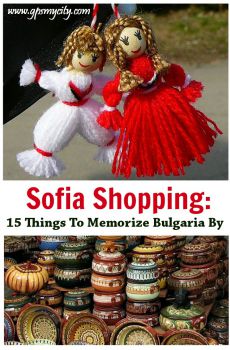
Ethnographic Museum, Sofia
The National Ethnographic Museum is located in the former Royal Palace, an impressive 19th-century building in the heart of Sofia, which holds significant cultural significance. Its primary mission is to collect, preserve, and showcase all aspects related to the cultural heritage of Bulgaria.
The museum boasts an extensive collection of over 50,000 items, categorized into various sections, including clothing, goldsmith crafts, copper artifacts, ritual objects, woodcarvings, agriculture, ceramics, textiles, home furnishings, carpets, foreign art, and more. It's worth noting that in the early 20th century, the museum was recognized as one of the most abundant cultural institutions in the Balkans. In the last fifteen years, the museum has organized over 50 exhibitions in Bulgaria and abroad, either independently or in collaboration with other museums.
The "Bulgarian Folk Wearing" fund is among the most significant resources within the museum. Preserving traditional folk attire, this collection serves as a vital source for understanding the ethnic unity and rich cultural heritage of Bulgaria.
The museum's collection also provides detailed insights into the traditional Bulgarian folk clothing, elucidating its structure, composition, and its roles in Bulgarian public life—whether worn for festive occasions or daily work.
Visitors to the museum can engage with knowledgeable curators who can share intriguing information about Bulgarian traditions and beliefs, which are intricately woven into the fabric of everyday life, both during weekends and workdays. One particularly captivating collection is dedicated to embroidery, which is considered a distinctive hallmark of Bulgarian folklore.
The museum boasts an extensive collection of over 50,000 items, categorized into various sections, including clothing, goldsmith crafts, copper artifacts, ritual objects, woodcarvings, agriculture, ceramics, textiles, home furnishings, carpets, foreign art, and more. It's worth noting that in the early 20th century, the museum was recognized as one of the most abundant cultural institutions in the Balkans. In the last fifteen years, the museum has organized over 50 exhibitions in Bulgaria and abroad, either independently or in collaboration with other museums.
The "Bulgarian Folk Wearing" fund is among the most significant resources within the museum. Preserving traditional folk attire, this collection serves as a vital source for understanding the ethnic unity and rich cultural heritage of Bulgaria.
The museum's collection also provides detailed insights into the traditional Bulgarian folk clothing, elucidating its structure, composition, and its roles in Bulgarian public life—whether worn for festive occasions or daily work.
Visitors to the museum can engage with knowledgeable curators who can share intriguing information about Bulgarian traditions and beliefs, which are intricately woven into the fabric of everyday life, both during weekends and workdays. One particularly captivating collection is dedicated to embroidery, which is considered a distinctive hallmark of Bulgarian folklore.
Want to visit this sight? Check out these Self-Guided Walking Tours in Sofia. Alternatively, you can download the mobile app "GPSmyCity: Walks in 1K+ Cities" from Apple App Store or Google Play Store. The app turns your mobile device to a personal tour guide and it works offline, so no data plan is needed when traveling abroad.
Ethnographic Museum on Map






Sight Name: Ethnographic Museum
Sight Location: Sofia, Bulgaria (See walking tours in Sofia)
Sight Type: Museum/Gallery
Sight Location: Sofia, Bulgaria (See walking tours in Sofia)
Sight Type: Museum/Gallery
Walking Tours in Sofia, Bulgaria
Create Your Own Walk in Sofia
Creating your own self-guided walk in Sofia is easy and fun. Choose the city attractions that you want to see and a walk route map will be created just for you. You can even set your hotel as the start point of the walk.
Sofia Introduction Walking Tour
"Ever growing, never aging" This is the motto of Sofia, capital city of Bulgaria. Under different names, the area of Sofia has had a 7,000 year history. Organized settlements around the area's hot water springs existed as early as the third millennium BC. A Thracian state union there was raided by Philip II of Macedon in 339 BC.
The Celtic Serdi provided the name... view more
Tour Duration: 2 Hour(s)
Travel Distance: 2.6 Km or 1.6 Miles
The Celtic Serdi provided the name... view more
Tour Duration: 2 Hour(s)
Travel Distance: 2.6 Km or 1.6 Miles
Communist Era Landmarks Walk
In the not-so-distant past Bulgaria was part of the Soviet-led Eastern Bloc. Today, this is one of the few countries where you can still find numerous relics of the Communist era manifested in monumental architectural landmarks. Concrete and metal were the main materials as a symbol of the industrialized nation, and the size was important too as a common architectural characteristic prescribed by... view more
Tour Duration: 3 Hour(s)
Travel Distance: 6.6 Km or 4.1 Miles
Tour Duration: 3 Hour(s)
Travel Distance: 6.6 Km or 4.1 Miles
Useful Travel Guides for Planning Your Trip
Sofia Shopping: 15 Things To Memorize Bulgaria By
Increasingly popular tourist destination in recent years, Bulgaria has opened up to the outer world, revealing colorful identity, manifested in rich craftsmanship, culinary and cultural traditions and history. The country's capital city Sofia is a lovely alloy of Eastern and Western European...



